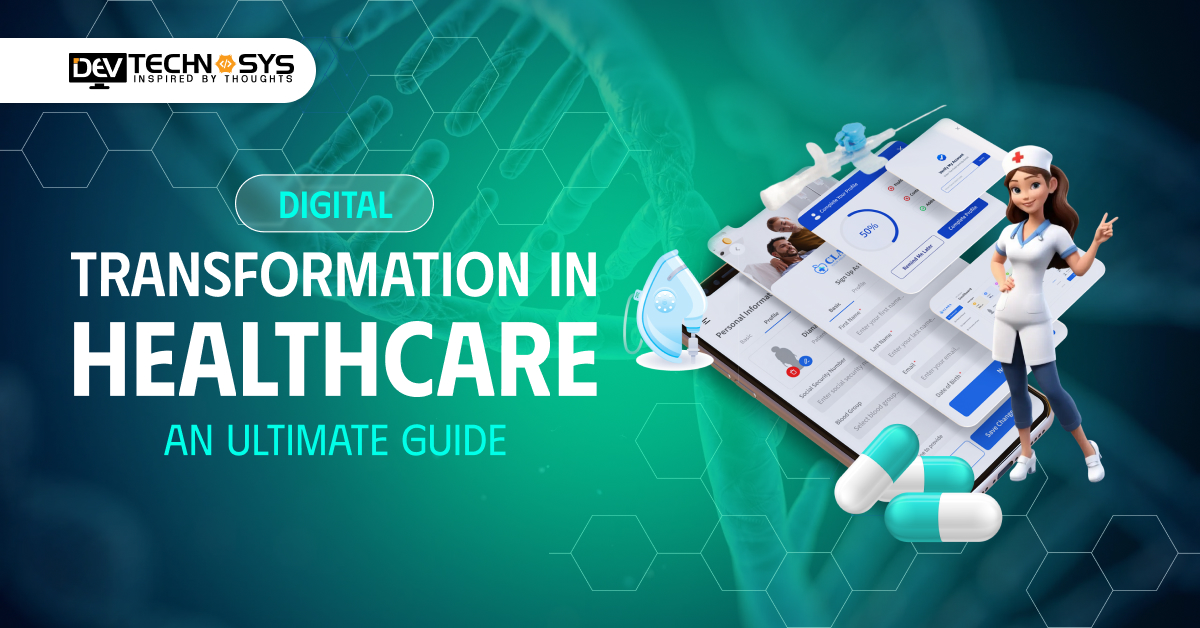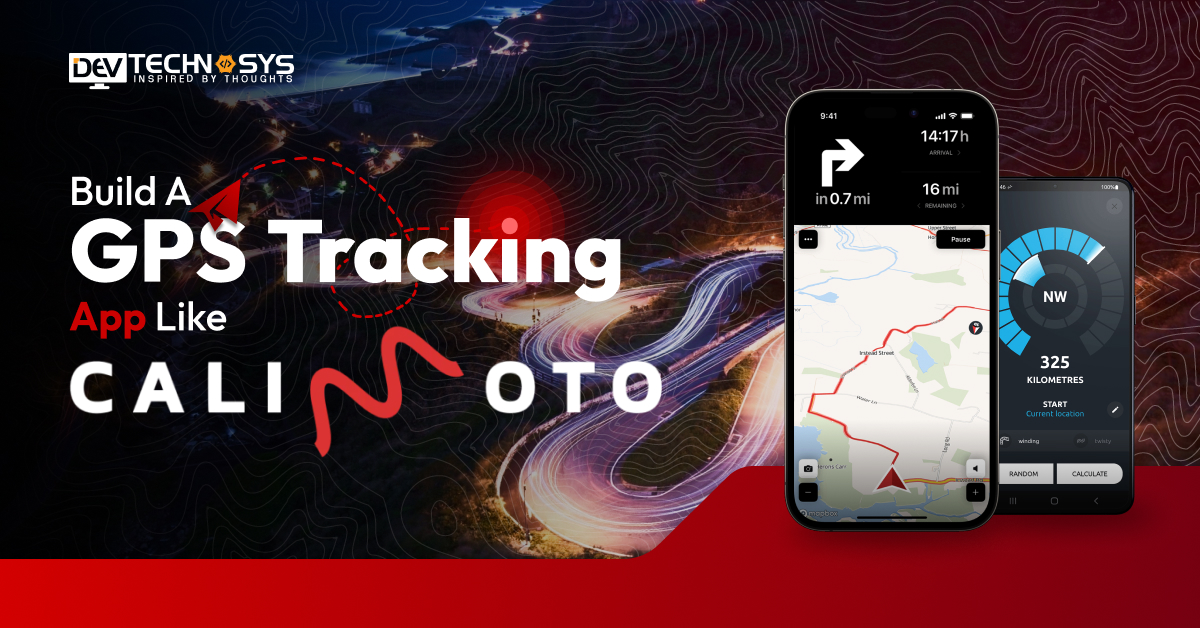The healthcare industry was once reserved only for skilled medical professionals. New innovations in technology lead to digital transformation in healthcare, as both experts and patients benefit from new digital healthcare solutions. These advanced solutions improve patient experiences. According to a survey done by Dolittle, 88% of healthcare technology experts and leaders stated that it is the main focus of their investments.
Keeping up with the ongoing hospital digital transformation is crucial for every healthcare professional, whether a doctor, nurse, hospital administration staff, or any other caregiver. In today’s blog, we will dive deep into the digital transformation in the healthcare industry and uncover various associated factors, and learn how it has transformed the healthcare industry.
This guide will explore the benefits of digital transformation in the healthcare industry, the latest technologies, examples of digital evolution in healthcare, challenges you may encounter, and practical steps to ensure success.
So, let’s begin!
What is Digital Transformation in Healthcare?
Digital transformation in healthcare uses new healthcare technology to enhance digital health solutions, deliver healthcare services, enhance patient care, and simplify processes. This includes using new healthcare technologies like electronic health records (EHRs), new biomedical devices, telemedicine, and data analytics for a more accessible, personalized, and efficient healthcare system.
With the rise of new technology in healthcare, the healthcare software development industry also flourished. Digital evolution in the medical field includes digitizing patient records and a wide range of measures that enhance patient care, streamline common processes, and improve the overall patient experience.
There are numerous benefits that digital transformation brings to the healthcare industry, including common use cases and key considerations for healthcare organizations to address the evolving needs of patients.
Market Overview of Digital Healthcare Industry
- The size of the Digital Health Market worldwide is expected to reach USD 347.45 billion by 2025. It is expected to reach USD 768.30 billion by the year 2030, at a CAGR of 2% during the predicted period (2025-2030).
- According to ROCK HEALTH, a venture capitalist company, in 2024, U.S. digital health startups secured USD 10.1 billion in funding across 497 deals, following a total of USD 8 billion raised in 118 deals in Q4.
- The digital healthcare market CAGR (growth rate) is expected to reach approximately 888% during the forecast period (2023-2035).
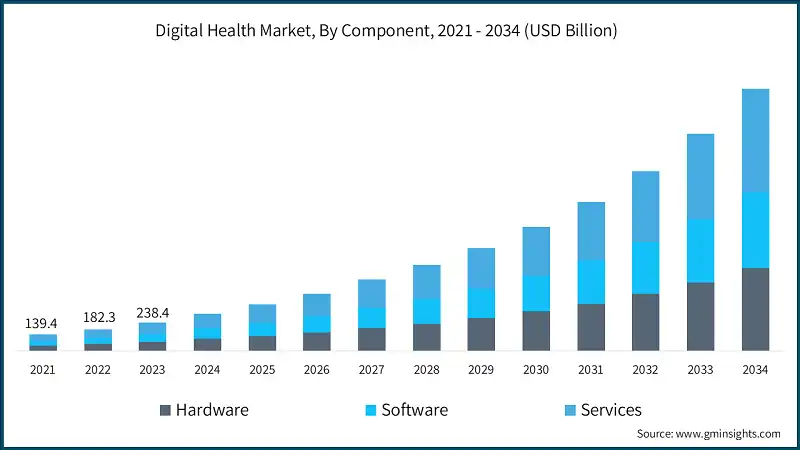
- Revenue is expected to show a CAGR of 88% between 2025 and 2029, resulting in a projected market volume of US$258.25 billion by 2029.
- In a global comparison, the majority of revenue is expected to be generated in the United States (US$54.00 billion in 2025).
Top 10 Healthcare Applications to Explore in 2025
Here are the top 10 types of healthcare software that you can explore in 2025:
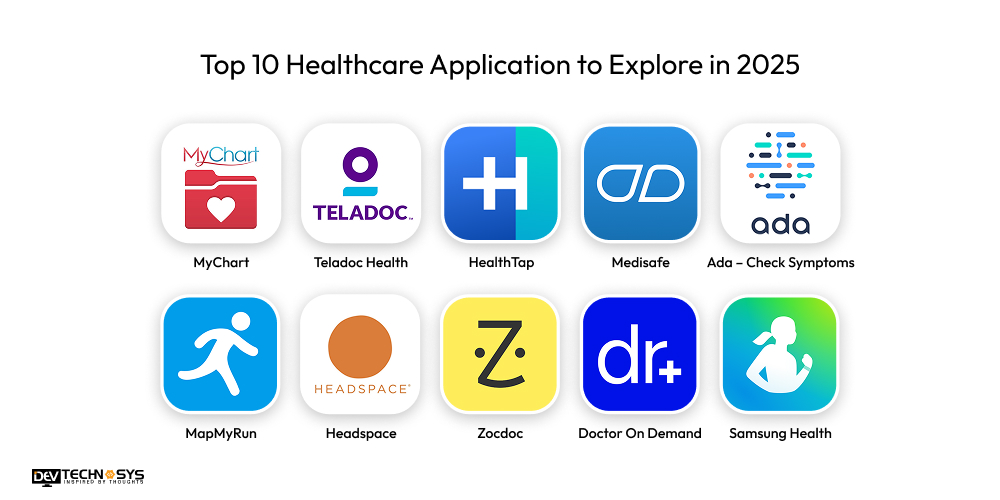
App Name |
Launch Year |
Store Rating (iOS/Android) |
Platform Availability |
| MyChart | 2010 | 4.8 / 4.6 | iOS, Android |
| Teladoc Health | 2002 | 4.8 / 4.3 | iOS, Android |
| HealthTap | 2011 | 4.9 / 4.2 | iOS, Android |
| Medisafe | 2012 | 4.7 / 4.5 | iOS, Android |
| Ada – Check Symptoms | 2016 | 4.8 / 4.6 | iOS, Android |
| MapMyRun | 2008 | 4.8 / 4.5 | iOS, Android, Web |
| Headspace | 2010 | 4.9 / 4.6 | iOS, Android, Web |
| Zocdoc | 2007 | 4.7 / 4.4 | iOS, Android, Web |
| Doctor On Demand | 2012 | 4.8 / 4.5 | iOS, Android |
| Samsung Health | 2012 | 4.6 / 4.2 | Android, Limited iOS Support |
Benefits of Digital Transformation in Healthcare
Digitalization in healthcare is necessary for several important reasons, some of which are given below. These patient outcomes allow better decision-making, encourage innovation, reduce costs, and unlock the doorway to greater accessibility.
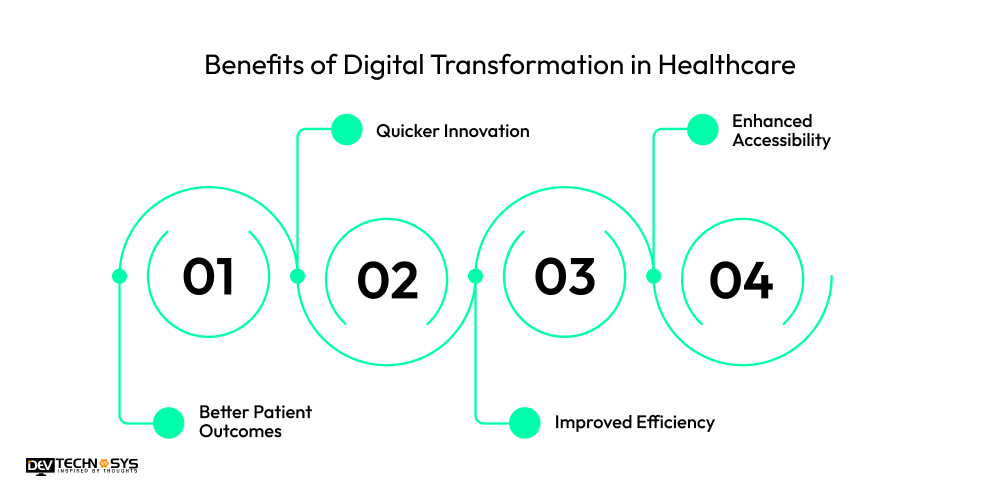
1. Better Patient Outcomes
The first benefit of digital evolution in healthcare is better patient outcomes. Some health-related concerns need more urgent inspection than others. When cases like that arise, every moment is crucial. Digital health records can provide patients with the necessary information and facilitate better communication between clinicians.
Digital changes in healthcare brings transparency to procedures and helps health professionals identify and provide efficient treatment for certain conditions, leading to better patient outcomes.
For example, Mental Health Electronic Health Record (EHR) software is specifically created to meet the unique documentation, treatment, and compliance needs of mental health professionals. Thus, several top companies are investing in mental health EHR software development.
2. Quicker Innovation
Digital transformation projects offer efficiency in multiple ways. New technology in healthcare helps staff simplify administrative processes, enhance the productivity of their care, stem medical errors, and reduce unnecessary procedures and tests. These efficiencies are cost-efficient and improve the healthcare experience for both caregiver and patient.
3. Improved Efficiency
Nowadays, mobile healthcare apps provide real-time access to data and information enabling more informed decision-making for healthcare providers. Machine learning development experts create this software to help medical care providers make time-sensitive and critical decisions with ease when they have access to timely data.
Digital transformation in healthcare can improve access and speed up the time of innovation. With a shorter feedback loop, healthcare professionals can access the data they need to understand the features and programs that are beneficial for both staff and patients.
4. Enhanced Accessibility
Patient expectations will continue to rise with advancements in technology. Most individuals navigating the healthcare system wish to have easy access to EMR and to easily contact a provider.
Digital technologies in the medical sector can employ various techniques to enhance the convenience and efficiency of healthcare services. It may include telemedicine, online access to information, self-service tools, and helpful automated workflows.
What are the Digital Health Tools for Patients?
According to a top AI development company, digital health tools empower patients to manage their health more independently, conveniently, and proactively. Here are some of the most widely used technologies improving patient care today:
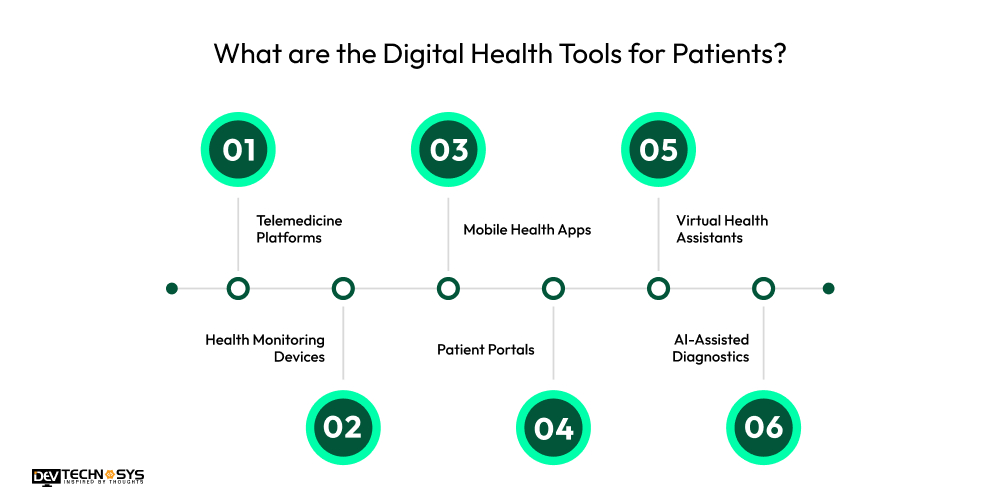
1. Health Monitoring Devices
New biomedical devices like fitness bands, smartwatches, and blood pressure monitors provide real-time insights into vital stats such as heart rate, oxygen levels, and sleep patterns.
2. Telemedicine Platforms
According to a top healthcare app development company, these platforms enable virtual consultations with doctors, therapists, or specialists, reducing the need for travel and wait times, especially for follow-ups and non-emergency care.
3. Patient Portals
Secure portals give patients access to lab results, prescriptions, and medical histories and allow easy appointment scheduling, all from a single online dashboard.
4. Mobile Health Apps
From tracking daily steps to managing chronic diseases, mHealth apps help users monitor medication schedules, receive health reminders, and improve lifestyle habits. There are many companies now investing in mHealth app development to fulfill the increasing demand for mobile healthcare apps.
5. AI-Assisted Diagnostics
An AI-powered tool and technology for hospitals, like AI-assisted diagnostics, can analyze symptoms or medical images.New biomedical devices can help with the early detection and diagnosis of medical conditions, flag abnormalities, and support doctors in making accurate and informed decisions.
6. Virtual Health Assistants
Patient monitoring app development providers must create intelligent virtual health assistants that use NLPs to answer health-related questions, provide medication alerts, and guide patients through care processes.
Examples of Digital Transformation in Healthcare
Below are some of the examples of digital transformation in healthcare. These digital solutions for startups have improved the healthcare industry, providing them unique and high-tech digital solutions.
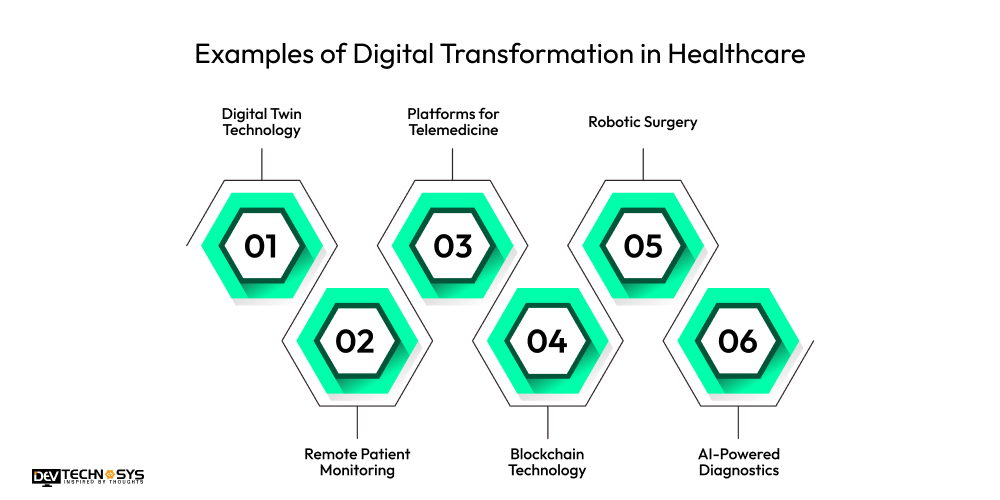
1. Digital Twin Technology
By building virtual versions of patients, digital twins in medicine enable predictive care, individualized therapy, and better health results. This huge impact of digitalization in healthcare is noteworthy.Digital twins in clinical trials help clinicians make better decisions and lower risks. For example, hospitals can use digital twins to monitor organ performance or simulate surgical procedures.
2. Remote Patient Monitoring (RPM)
Wearables and other IoT-powered devices allow physicians to monitor their health in real time, reducing the risk of hospital revisits. With visiting the continuous glucose monitoring systems, Medtronic’s IoT solutions help manage long-term illnesses like diabetes.
3. Platforms for Telemedicine
Telemedicine app development has empowered rural communities the most. Telemedicine apps like Teladoc Health enable people in rural areas to receive medicinal care, allowing patients to consult doctors from anywhere.
4. Blockchain Technology for Safe Data Exchange
Businesses utilize blockchain technology like Medicalchain to transfer the patient’s records and data among healthcare professionals. It improves data secrecy, security, and cooperation.
5. Robotic Surgery
One of the examples of digital transformation in the wellness sector is robotic surgery. Da Vinci surgical systems improve accuracy and shorten recovery periods by performing minimally invasive procedures using robots and artificial intelligence.
6. AI-Powered Diagnostics
Medical Centers and hospitals are now using new healthcare technology called digital twins to assess medical images, increasing accuracy and speeding up diagnoses. For example, Google Health’s AI technology is more accurate in detecting breast cancer than human radiologists in mammograms.
Top Challenges to Digital Transformation in Healthcare
Improved patient care and efficiency in operations are two potential benefits of digital transformation in the healthcare industry. But this path of development has its own set of challenges. Multiple healthcare challenges must be removed for a smooth shift from conventional techniques to a more creative, patient-centered approach. Let’s check out these healthcare challenges:
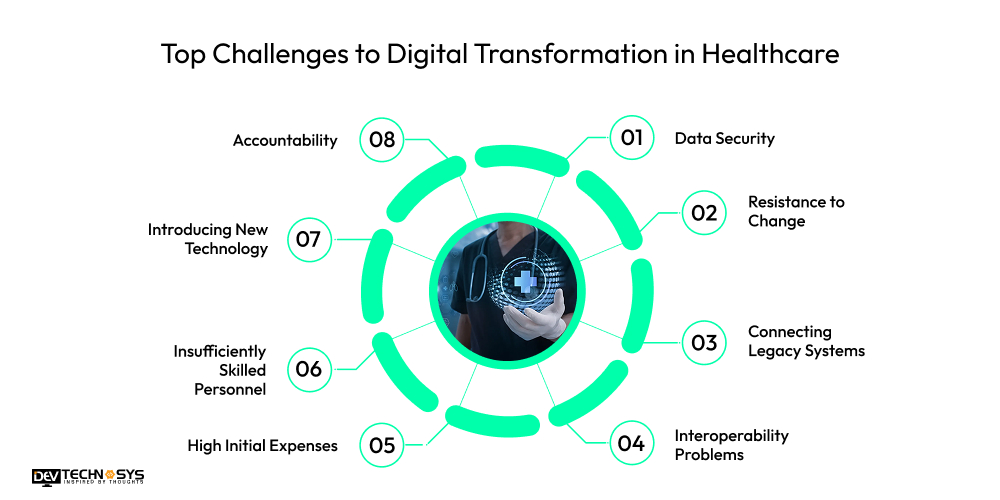
1. Data Security
One of the most prominent healthcare challenges is to keep records containing patents’ sensitive information secure and private. The healthcare industry handles a large number of sensitive personal data. Whether it’s patient records or genetic information, this brings an increasing risk of data leaks, cyberattacks, and privacy violations.
- Why it matters: It could cost millions for a simple breach of data and severely damage an institution’s reputation.
- Solution: It is essential to invest in encryption standards, high-tech cybersecurity systems, and strict access controls.
- Real-world concern: Attacks on hospitals for ransom demands have rapidly increased in recent years.
2. Resistance to Change
Healthcare professionals often rely on familiar digital health solutions and processes as they are hesitant to adopt new tools due to concerns about learning curves, fear of workflow disruption, and skepticism about tech reliability.Training, clear communication, and involving end-users early in the transformation process can reduce friction.
3. Connecting Legacy Systems
Another healthcare challenge in digital transformation in the healthcare industry is securing legacy systems. Most hospitals and clinics still use software and machinery that are decades old and often developed decades ago. These legacy systems:
- Absence of modern integration abilities
- Supports cloud-based or mobile platforms
- Delay in data exchange and interoperability is possible
Example: Developers providing healthcare app development services need to introduce new technologies as an EHR system from 2005 may not communicate efficiently with a modern telehealth solution, requiring costly middleware or full system replacement.
4. Interoperability Problems
Sometimes, a new healthcare digital strategy can have an issue or two. The ability of different systems to interpret and exchange data is one of healthcare’s most significant pain points.
- Different vendors use proprietary formats
- No unified data standard exists globally
- Patient history is often scattered across providers
The healthcare digital transformation trends include adopting standards like FHIR (Fast Healthcare Interoperability Resources) and incentivizing vendors to build more open platforms.
5. High Initial Expenses
The recent hospital digital transformation may lead to high initial expenses. Implementing digital health solutions can be costly:
- Licensing fees for EHR systems
- Investment in cloud infrastructure
- IoT devices, AI tools, mobile apps, and training costs
Especially small clinics and rural hospitals may find these costs prohibitive without government funding or grants.
6. Insufficiently Skilled Personnel
Many healthcare facilities lack in-house IT teams or digital health experts. Challenges include:
- Shortage of health informatics specialists
- Doctors and nurses unfamiliar with digital tools
- High turnover in tech roles
Upskilling staff and partnering with digital health consultants are key steps toward filling this gap.
7. Combining New Technology
Modern healthcare digital transformation trends, such as AI, machine learning, IoT, and remote monitoring, are highly beneficial but can’t always integrate seamlessly into existing workflows or systems.
- AI algorithms need quality datasets from EHRs to perform
- IoT sensors must communicate with hospital servers in real time
- Cloud solutions must comply with on-premise data storage policies
- Strategic planning and hybrid cloud infrastructure can help ease the transition.
8. Accountability
Healthcare is among the most heavily regulated sectors globally. The best medical practice management software development companies must create high-tech digital solutions that comply with the following:
- HIPAA (USA)
- GDPR (EU)
- NDHM (India’s National Digital Health Mission)
- Local clinical data governance standards
Navigating regulatory approvals, documentation, and audits can delay rollout and increase compliance costs.
Steps to Implement Digital Transformation in Healthcare
Here are the crucial steps you need to follow in order to implement digital tools and technologies in healthcare:
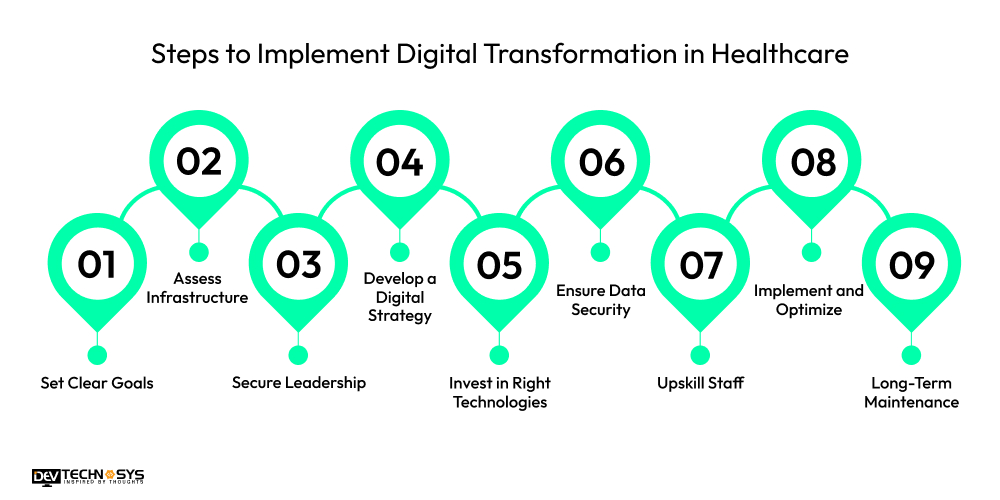
1. Set Clear Goals and Vision
Start by defining what you aim to achieve—better patient care, faster workflows, or lower costs. Align digital goals with your organization’s mission and ensure measurable outcomes are in place from the start.
2. Assess Current Infrastructure and Readiness
Check and analyze existing technology, data systems, and staff capabilities. This helps identify what can be improved or replaced to support digital tools effectively and securely.
3. Secure Leadership Buy-in and Stakeholder Engagement
From the beginning of the process, make sure to engage all the decision-makers, IT staff, and clinicians. With their support, you can ensure a smoother adoption, faster implementation, and fewer hurdles to access various medical and health departments.
4. Develop a Scalable Digital Strategy
It is crucial to make a scalable digital strategy or flexible roadmap that clearly states priorities for both short-term and long-term goals. Make sure to target areas that may have a bigger impact. It may include areas like EHR, telemedicine, automation, and patient portals.
5. Invest in the Right Technologies
This step includes selecting various tools that are not only secure but scalable and interoperable as well. Solutions like cloud-based EHRs and IoT-enabled monitoring improve healthcare and reduce manual labor.
6. Ensure Data Security and Regulatory Compliance
In this step, the need arises to implement strong security measures to ensure the safety and confidentiality of sensitive data. Also, compliance with HIPAA and GDPR, as well as local data protection laws, like regulations are also necessary to minimize legal risks.
7. Upskill Staff and Promote Digital Literacy
Give training to new healthcare experts and give instructions and information to staff on new tools and platforms. Encourage a digital mindset through continuous learning and support to ease the transition.
8. Implement, Monitor, and Optimize
This step concludes deploying digital solutions gradually and making sure to track the performance with the help of KPIs. You can maximize efficiency and user satisfaction by gathering feedback from them in real-time, monitoring their outcomes, and enhancing existing systems.
9. Ensure Long-Term Maintenance and Innovation
However, digital transformation in the healthcare sector does not end with the previous step. Experts need to set up regular updates and support systems and explore new technologies to future-proof your healthcare services.
How to Approach Digital Transformation as a Healthcare Provider
There’s a lot more that goes into the digital revolution in healthcare. Cultural, strategic, and operational shifts are needed across the organization. Here’s what healthcare providers need to do to approach digital transformation:
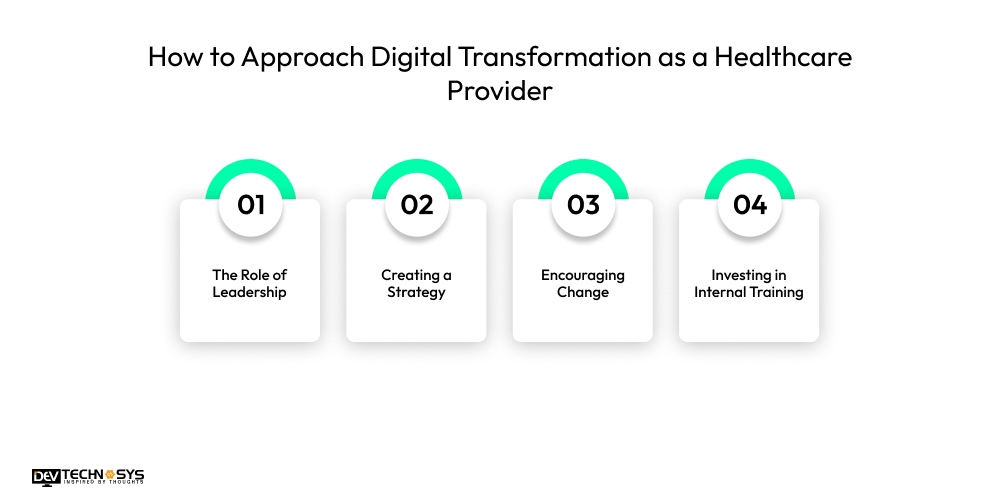
1. The Role of Leadership
Strong leadership is crucial for building on vision, securing funding, and embracing a culture of innovation. Leaders must champion the Change, align teams, and adequately explain to stakeholders all the benefits that digital transformation brings to the healthcare department.
2. Creating a Strategy
Based on what your organization targets, you need to develop a clear, actionable roadmap. Also, incorporate patient needs and operational challenges while making decisions. The strategy should outline key priorities, timelines, technology choices, and measurable outcomes. Create a concise, transparent, and operational challenge.
3. Encouraging and Managing Change
There are a lot of hurdles you might face while shifting towards digitalization. Showcase how digitalization in healthcare can improve delivery and efficiency in operations. Don’t forget that change is the key ingredient in ensuring long-term success.
4. Investing in Internal Training
Hire a skilled team of experts who can skillfully implement the new technologies. Offer ongoing training, hands-on support, and learning resources to build digital competence and encourage innovation from within.
Future Trends in Digital Healthcare Transformation
People will continue to lean towards digital healthcare solutions in the coming years. The benefits and increased efficiency they provide are too obvious to ignore. As the healthcare sector becomes more accepting of digital solutions and services, the following trends are sure to gather momentum.
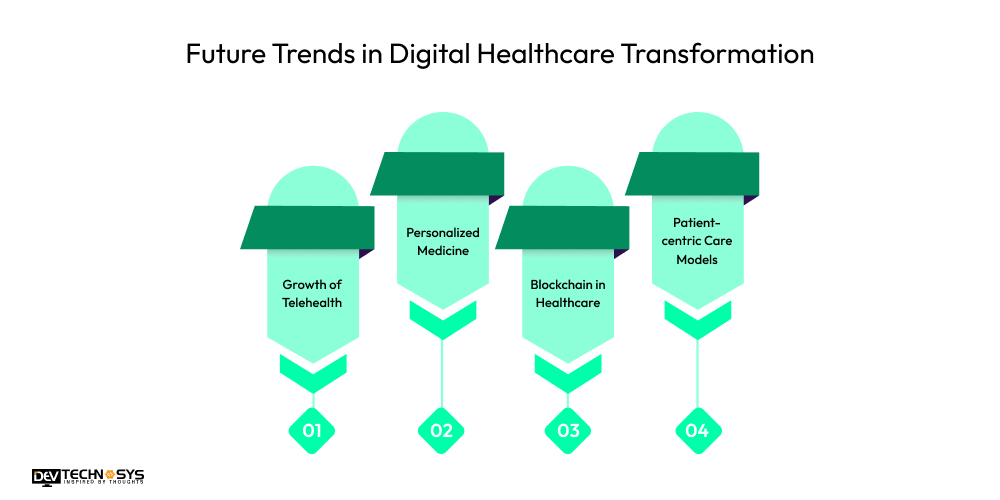
1. Continued Growth of Telehealth
The shift toward healthcare digital transformation will continue in the coming years. Many more patients will start using telehealth solutions as more healthcare organizations set up the appropriate infrastructure. Investing in telehealth is a good way to bring any healthcare organization into the future.
2. Personalized Medicine and Genomics
Automatic, AI-enhanced analytics and detailed EHRs will play a significant role in devising patient treatments in the future. AI is also powering breakthroughs in gene sequencing, which can be used to recommend personalized medicine to patients based on their genetic profile.
3. Blockchain in Healthcare
While most often thought of in relation to cryptocurrency, private blockchains serve an important purpose in digital healthcare. Blockchain app development has helped the healthcare industry in numerous ways. The viability of blockchain technology as a way to safely store encrypted data on a private network makes it a perfect fit for the healthcare sector’s need for secure digital archives.
4. Patient-centric Care Models
Digital healthcare democratizes access to medical services. As digital upgrades in healthcare continue to change the industry, more patients than ever before will benefit from a range of services that were earlier out of their reach. Smart patient portals will also let patients access their records and information more easily, giving them a sense of control over their own treatment.
Conclusion
Finally, we reached here! We hope the above-presented information has helped you learn better about digital transformation in the healthcare industry. As we know and discussed in the above blog, the market of the digital healthcare sector is on the rise, presenting many lucrative opportunities for entrepreneurs and established businesses to invest in digital healthcare solutions.
If you are a business looking for an agile healthcare software development company, then don’t hesitate to contact Dev Technosys. Our skilled team of experts possesses knowledge of biomedical devices and the latest digital health solutions, and they implement them while creating a top-notch digital healthcare mobile application for you. For more informative content, stay tuned.
Frequently Asked Questions
1. How Has Digital Transformation Changed the Healthcare Sector?
Digital transformation brought many changes in the healthcare sector. Modern technologies like apps, cloud software, and AI have completely changed the way doctors treat patients, manage data, and run hospitals or clinics more efficiently.
2. Why Is Digital Transformation Important For Hospitals And Clinics?
It helps improve patient care, reduces paperwork, saves time, and allows healthcare providers to give better, more personalized services. It also helps hospitals run smoothly with fewer errors.
3. What Are Some Examples Of Digital Healthcare Tools?
Common tools include telemedicine platforms for video doctor visits, mobile health apps, wearable fitness trackers, digital prescription systems, and electronic health records (EHRs).
4. Is Digital Transformation Only For Big Hospitals?
No, even small clinics and individual doctors can use digital solutions like appointment booking systems or cloud-based patient records to simplify work and serve patients better.
5. How Does Digital Transformation Help Patients?
Patients get faster access to care, can speak to doctors from home, receive health alerts, view medical records online, and get reminders for medication or appointments, all through their phones or computers.
6. Is My Health Data Safe With Digital Systems?
Yes, if the healthcare provider uses secure systems that follow rules like HIPAA or GDPR, your personal health information is encrypted and protected against leaks or hacks.
